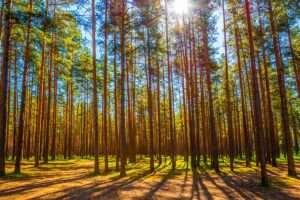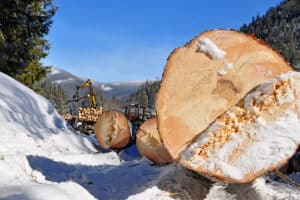The previous four columns have discussed different ways that the volumes and monetary values in a timber cruise can be inflated. Timberland buyers need to protect themselves from seller-supplied information of this type. How does a buyer go about doing this?
Acquire basic knowledge. Timberland buyers should think of themselves as consumers. Whether you’re a first-time timberland buyer or experienced, you should become familiar with the timber characteristics, markets and idiosyncrasies of the area that you are prospecting. Forest types differ, often within counties. So a timberland buyer must focus on learning about a particular area. Basic, general information can be obtained from:
Extension foresters in the area. These university-based folks can provide publications and general answers to your questions. They will not review a cruise for honesty. They can point out things to look for on tracts in a particular area, such as infestations and damage from fire or wind storms. Contact the county’s local office of the state’s cooperative extension service, or online through the forestry department at a state’s land-grant university.
These departments also have forestry specialists on matters ranging from timber taxation to invasive species.
County forester. Most states have county (local) foresters who work with the public, primarily with landowners. They will not review a cruise, but they will be familiar with local conditions.
Some states have begun a landowner mentoring program for new forest landowners that may be open to new timberland buyers as well.
County Soil Survey. This document provides soil maps for an entire county. It is free, and available either online or in hard copy. Each soil type is ranked for its productivity for growing local timber. The higher the “site index,” the more productive the dirt. The Soil Survey will show a land buyer what a property’s soils are and are not suited for. Contact the local office of the USDA’s Natural Resources and Conservation Service.
State’s timber market reports. Many states support a reporting service through their forestry division that tracks prices for stumpage, that is, recent prices paid for various species and types (veneer, sawlogs, pulp, etc.). These reports may lag current prices by a quarter or more, and they are averages for an area. Stumpage prices on state or federal lands are almost always lower than prices paid to private landowners owing to the requirements imposed.
State forest-landowner groups. Many states have non-profit organizations of forest landowners who are actively involved in promoting private timberland interests.
A buyer might find a member in the area he’s targeted who’s willing to discuss local conditions and personalities.
Publications. A number of books and publications are available on managing timberland, forest health, harvesting techniques and issues and related topics. Sample contracts are available that provide a general approach for a landowner to hire a logger and a consulting forester. Relatively little material is available that explains how an inexperienced buyer should approach buying timberland and evaluate seller-supplied cruises. I devote several chapters to this subject in my book, How To Be a DIRT-SMART Buyer of Country Property, but my discussion is limited to deconstructing a hardwood sawtimber cruise. Different issues arise in northern hardwoods, pine plantations and West Coast timber.
Consulting foresters. Once a novice timberland buyer acquires basic knowledge through these sources, he should develop a relationship with a consulting forester who works the target area. PART VI will discuss how to find and work with a private consulting forester.
This content may not be used or reproduced in any manner whatsoever, in part or in whole, without written permission of LANDTHINK. Use of this content without permission is a violation of federal copyright law. The articles, posts, comments, opinions and information provided by LANDTHINK are for informational and research purposes only and DOES NOT substitute or coincide with the advice of an attorney, accountant, real estate broker or any other licensed real estate professional. LANDTHINK strongly advises visitors and readers to seek their own professional guidance and advice related to buying, investing in or selling real estate.









Please refer back to my comment on Part IV. You can’t overlook the importance of the timber buyer. Local timber buyers who are also professional forester will have more knowledge of the current market prices and log specs than any other source. They will give sound advice, considering they want to build a long-term business relationship. Many timberland buyers use the knowledge of the timber buyer when determining the value of the timber before the purchase and may later use a forestry consultant when selling timber. The owner can also use the forest management knowledge of the consultant after the purchase with his services of writing a management plan, marking boundaries, prescribed burns, tree planting, and marking timber if needed.
My experience differs from Mr. Cann’s.
While timber buyers — mills and loggers — are the ultimate source of information about current timber and stumpage prices, my experience is that they are reluctant to share this information with prospective timberland buyers. My experience is that a (small) timberland buyer needs to work with a well-experienced, licensed consulting forester who has worked in the target area. That forester will have contacts with stumpage buyers and will be able to get accurate information on the various species prices paid by different buyers. This is not a DIY job in my experience.
A timberland buyer is also in a precarious position with a mill or a logger he might consult about prices. If the timberland buyer has found a good property, it’s quite likely that the mill or logger with whom he shares information will backdoor him, that is, buy it quickly.
Further, a mill or a logger will always try to work an exclusive deal with a new timberland owner rather than allow a consulting forester representing the landowner to conduct a competitive, sealed-bid sale, which, in my experience, nets the most money for landowners. Sales are handled differently in different areas, and it’s very difficult for a timberland buyer who is not in the business to learn the ropes. That’s why I recommend that new timberland buyers find a consulting forester to help them evaluate potential sale properties and then manage any sales. The research shows that consultant-managed sales do better than unilateral negotiations between landower and mill or logger.
My experience is that a new timberland buyer should let his consulting forester work with stumpage buyers on determining prices prior to the purchase of a timberland property.
I appreciate your reply. I agree that a fiduciary relationship that a consultant will give can be important with an buyer. Things have changed in the Southeast over the past ten years. Most mills are concentrating on making a product. Loggers are busy logging. The new timber buyer is usually an experienced, liscensed, proffesional forester that spends time exclusively prospecting, buying from owners, selling to mills, and monitoring jobs. My point is, you do not have to call a consultant to get an experienced, licensed, professional forester and the most accurate timber estimation.
I will tell you another important reason to call the local professional forester/timber buyer. He knows every timberland owner in his/her county. He will call or visit most of them and has walked over most of the land. If you would like to know who has land for sell (most of which is not listed with a broker) take the timber buyer out for breakfast every now and then!